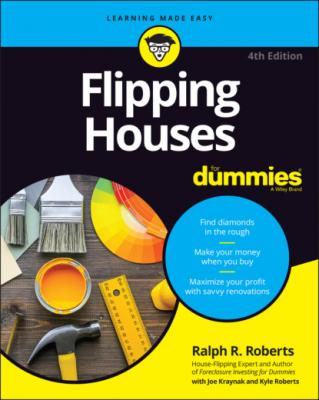ТОП просматриваемых книг сайта:
Flipping Houses For Dummies. Ralph R. Roberts
Читать онлайн.Название Flipping Houses For Dummies
Год выпуска 0
isbn 9781119861034
Автор произведения Ralph R. Roberts
Жанр Недвижимость
Издательство John Wiley & Sons Limited
Chapter 16 shows you how to landscape and prepare the exterior of the house to make it draw passersby inside for a closer look.
Focusing on kitchens and bathrooms
Depending on their condition, kitchens and bathrooms have the ability to sell houses or sink deals. A spacious kitchen with plenty of counter space and all the essential amenities — a clean range, refrigerator, microwave oven, and dishwasher — creates an impression that the kitchen is an inviting place to prepare meals and hang out with friends and family members. A sparkling-clean, well-lit bathroom with plenty of storage space creates a sense of comfort and cleanliness that permeates the house.
Making moderate changes
Somewhere between painting a room and building a room addition are moderate changes that you can make to a house to improve its value and draw more buyers. These improvements include installing replacement windows, replacing the screen doors or entry doors, and refinishing wood floors or installing tile or vinyl flooring. Chapter 18 lays out your options.
Tackling structural enhancements
Some houses are begging for a few major overhauls. Maybe the house has an unfinished attic that’s perfect for an additional bedroom or a beautifully landscaped backyard that has no easy access and no deck or patio. In some cases, you may discover a dinky house surrounded by mansions. By raising the roof and building a second story, you can double the living space and boost the house into a higher bracket. Chapter 19 takes on some of these major renovations, which may inspire your own creative visions.
Profiting from Your Venture
Although this book focuses on the buy-fix-sell approach to flipping houses, you can profit from a flip in numerous ways, including these strategies:
Sell the property.
Sell to an investor who’s better equipped and more motivated to flip the property (you’re essentially earning a finder’s fee, also known as the bird-dog fee).
Refinance to cash out the equity in the property — usually, to help finance repairs and renovations or to use the money for other investment properties.
Sell the property on a lease option (rent-to-own), essentially collecting rent with the hope that your tenants will eventually purchase the property.
Lease the property — become a landlord.
Sell the property on a contract, acting as a bank and collecting the interest.
See Chapter 20 for details on the various approaches to profit from a flip. In Chapters 21 and 22, I explain how to market and sell your home for top dollar. And in Chapter 23, I explain certain tax considerations that may help you keep more of your profit by paying less of it to your rich Uncle Sam.
Chapter 2
Devising an Effective Flipping Strategy
IN THIS CHAPTER
Our goals can only be reached through the vehicle of a plan. There is no other route to success.
—PABLO PICASSO
Before making an offer on a house, know how you’ll profit from it. Will you buy it at a bargain and resell it immediately at market value (or for less, to sell it faster), do a quick makeup job and resell it, perform a few major renovations, or fix it up and use it as a rental? Each of these strategies has benefits and drawbacks, but each strategy is a perfectly legitimate way to flip property for a profit.
This chapter explores several house flipping strategies and encourages you to develop your own strategy based on your neighborhood, the resources you have at your disposal, and your preferred approach.
Deciding on the Role You Want to Play
Flipping a house generally involves buying it, fixing it, and then selling it, but you can profit from this overall process in various ways — depending on how involved you want to be in each of these three progressive steps:
Do it all yourself. Casual flippers often do it all (or mostly) by themselves — buying the property with their own money (or a conventional loan), completing most of the repairs (and hiring professionals to do anything beyond their level of expertise), and listing the home. Maybe these flippers have a real estate agent help them navigate the buying-and-selling process. This approach may be the most profitable, especially if you live in the home you’re flipping. Making all the repairs yourself isn’t necessarily the most profitable approach. If you take a long time to complete the repairs, holding costs (interest, insurance, utilities, maintenance, and so on) can eat away your profits.
Delegate the heavy lifting. Experienced flippers often delegate most or all of the work, buying and selling properties through an agent and hiring a contractor to coordinate the repairs and renovations. Sometimes, experienced flippers play the role of contractor, hiring subcontractors (electricians, plumbers, painters, and others) to do the work. Hiring out the work increases repair and renovation expenses, but it can speed the process and reduce holding costs.
Put up the money. If you have money to invest and don’t want to get your hands dirty, you can loan money to people who are willing to do all the work and charge them interest. Or, you can partner with a flipper for a percentage of the profits (assuming that the flip generates a profit).
Bird-dog it. Bird-dogging (also referred to as wholesaling) involves buying and selling contracts. You’re a

